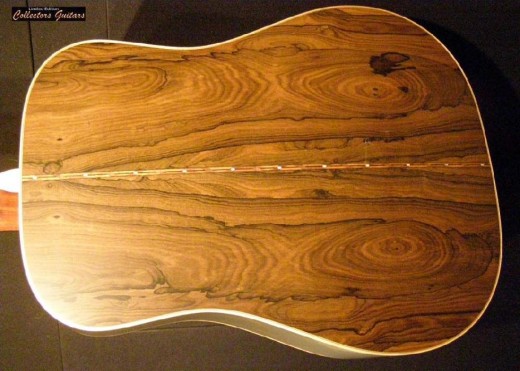Persimmon wood backside of the Takamine 40th anniversary guitar

Takamine 40th Anniversary Dreadnought
Takamine instruments have been around for more than 40 years now. In fact, at this time Takamine's 50th anniversary model guitars are available, but looking through some old Acoustic Guitar magazines I found an article, a much shorter one than this will be, about the 40th anniversary Takamine guitar, and I was exceedingly intrigued by the facts of its construction.
Now I do a lot of writing about acoustic musical instruments on the web, and I mean on this site, and on a few others as well. Most often when I'm talking about a six string guitar in an online article, I know that instrument, I've sat in guitar shops and played that guitar, and so I can tell you I know what I'm talking about. I can not do that with this guitar, and probably very few people can. The Takamine 40th anniversary guitar resulted in the production of just 40 of these instruments. Very few people anywhere can tell you first hand about this guitar. What I want to talk about concerning the thing is how frigging unique a guitar it must be.
I don't know if too many peripheral six string fans have figured this out, or not, but the people who are rabid about guitars and guitar building are a pretty intellectual lot of folks. Building fine guitars is akin to being a sculpture in a way, except the guitars, the work of art they build, are then taken and used towards further works of art. Guitar builders are extremely interested in pieces of woods, taptones, and such; and what the combinations of woods and bracing they use to build a guitar is going to produce in the sonic sense.
While I'm not any sort of professional scholar in regards to acoustic instruments, I'm sure enough an amateur one. I don't have transportation just now, so I do not get to visit music shops so much, but I'd never before heard of a guitar besides this one having persimmon wood used for its back and sides. I brought the topic up to an uncle who used to sell guitars, and knows quite a lot about them, and he'd said himself he thought I must be mistaken, that there would be a great challenge in finding persimmon wood slabs big enough to make a dreadnought guitar, and this Takamine 40th anniversary instrument is certainly a dreadnought.
Persimmon Wood And Acoustic Guitar Building
Persimmon as a tonewood is uncommon, very uncommon. Using Google search I searched terms "dreadnought guitar with persimmon back and sides," and I found only two entries that looked decent at first glance. A man in Eastern Tennessee named Cliff Hamby[1] uses persimmon and other native trees to make hand made instruments, and another man named Bob Gramann[2], a newer builder. Persimmon wood is thought of as a native American ebony[3], and ebony, of course, has been used in acoustic instrument building for a very long time, and on the most expensive of instruments as the wood used for bridges and fretboards.
My search results linked above for "dreadnought guitar with persimmon back and sides" were essentially completely useless. Those builders in the first two references aren't using persimmon for back and sides, but for fretboards or bridges, or both. So I hope the reader can see how completely intriguing this Takamine instrument truly is.
This 40th Anniversary instrument from Takamine is a standard 14 frets clear of the body dreadnought. We've discussed the back and sides being persimmon, and the top is sitka spruce. The guitar features abalone inlay binding, an abalone rosette; and a 40th anniversary commemorative ruby. Fretboard markers are bow tie style. The instrument has a strange two piece style saddle which I'm not exactly sure how to name properly. Only 40 of these instruments were made, and when new, they sold for $4,000. I priced one today on the web for $2,000 used. This is an extremely rare "bird," and I wish I could find at least a youtube video about it, but alas, I can not. The persimmon wood looks a lot like Koa, and I can only wish to hear what these beauties sound like.


 1:19 PM
1:19 PM
 Wesman Todd Shaw
Wesman Todd Shaw

0 comments:
Post a Comment